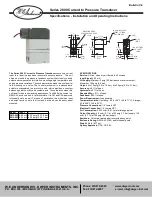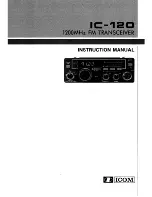
Small Wonder Labs
PSK-20 Transceiver Kit 03/09/10
2000
7
during transmit. Without this feature, the receiver
output will be mixed back through the soundcard (in
parallel with the desired DSP-based transmitter drive)
and cause transmitted signal distortion. MOSFET Q12
provides this function by shorting the receiver output
to ground during transmit.
T-R Switching:
T-R switching is controlled by dual comparator U5 and
associated components. 'RTS' or 'DTR' (DigiPan uses
RTS). is provided by the host computer via the serial
port connection, and is a bipolar signal of
approximately +/- 10V in amplitude. It is negative (-
10V) on receive and switches positive on Transmit.
U5-A rests at 0V during receive and switches to V+ on
transmit. This turns on (unmutes) TX audio FET Q4. It
also turns on RX muting FET Q12.
Comparator section U4-B turns the transmitter bias
switching (Vsw) on a few milliseconds later. This time
delay eliminates a transmitter transient caused by the
shifting DC levels when Q4 turns on. 'Catch' diode D7
rapidly turns off the bias supply when switching back
to Receive to eliminate a similar transient.
The receiver's T-R switch function is provided by C1
and L1, which form a series-resonant circuit. Diodes
D1-D4 limit during key-down and thereby restrict the
signal levels presented to the receiver front-end during
transmit. The double-diode configuration raises the
network's intercept point with respect to W7EL's
original configuration to improve IMD immunity.
Transmitter operation:
Audio from the computer soundcard is applied to
the transmitter via J2 or J3. Q4 is switched on during
transmit and allows soundcard audio to reach the
amplifier stage (Q5 and associated components). Note
that when Q4 is off during 'receive', DC bias is
removed from Q5 and it is also non-conducting. The
combination of Q4 and Q5 provide relatively high
attenuation (>60 dB) of the soundcard audio during
receive. This is necessary since the transmitter's DSB
generator is running continuously- an audio signal
applied to that stage's input would be plainly audible
through the receiver. This situation would lead to
soundcard feedback/distortion on receive without the
presence of this muting function.
Q6 is an emitter follower which provide a 51-ohm
source termination for diode-ring mixer U6. U6 is
driven by a signal from the 9MHz LO, Colpitts
oscillator Q7 and associated components. The output
of mixer U6 is a suppressed-carrier double-sideband
signal. After passing through the transmit IF filter
comprising Y7-Y10 and related components, the signal
has been reduced to 9 Mhz SSB signal.
U7 is an active mixer and is fed by the 9 Mhz SSB
signal and by a 5.07 Mhz LO signal from Colpitts
oscillator Q8 and associated components. The output
of this mixer consists primarily of both the sum (14
MHz) and difference (4 Mhz) frequencies applied to
the mixer. Q9 is an emitter follower used to buffer the
high-impedance output of the mixer. U8 is a
Monolithic Microwave IC (MMIC) and provides
approximately 12 dB of gain.
Because the output of mixer U7 has energy on a
number of frequencies, bandpass filtering is required to
clean up its spectrum. L8, L9 and associated capacitors
form this filter, with input and output impedances of
50 ohms.
Q10 and associated components are the
transmitter's driver stage. This stage is feedback-
controlled by R50 for good linearity and operates
class-A (always conducting). The output of this stage
is L-network matched via L10 and C38 to the Power
Amplifier (PA) base. D11 biases the PA base to the
threshold of conduction, necessary for linear operation.
The PA stage (Q11) features a bifilar transformer (T2)
at its collector. This provides a 1:4 impedance match,
transforming the LO collector impedance at rated
power to 50 ohms. L11-L13 and C40-C43 are a 7-pole
lowpass filter used to remove harmonic content from
the PA output waveform. The design with current
FCC requirements for spurious emissions. All
harmonics were down at least 45 dB. The largest
spurious output is down 50 dB.
Output Indicator:
Diodes D13,D14 and associated components are a
peak detector circuit and may be used to as an RF
output indication. If you like, a 'T1-3/4' LED may be
installed at TP2 on the board- this serves as a
modulation indicator. This diode may alternatively be
mounted remotely to the circuit board, since it's
decoupled for RF frequencies by C122.








































